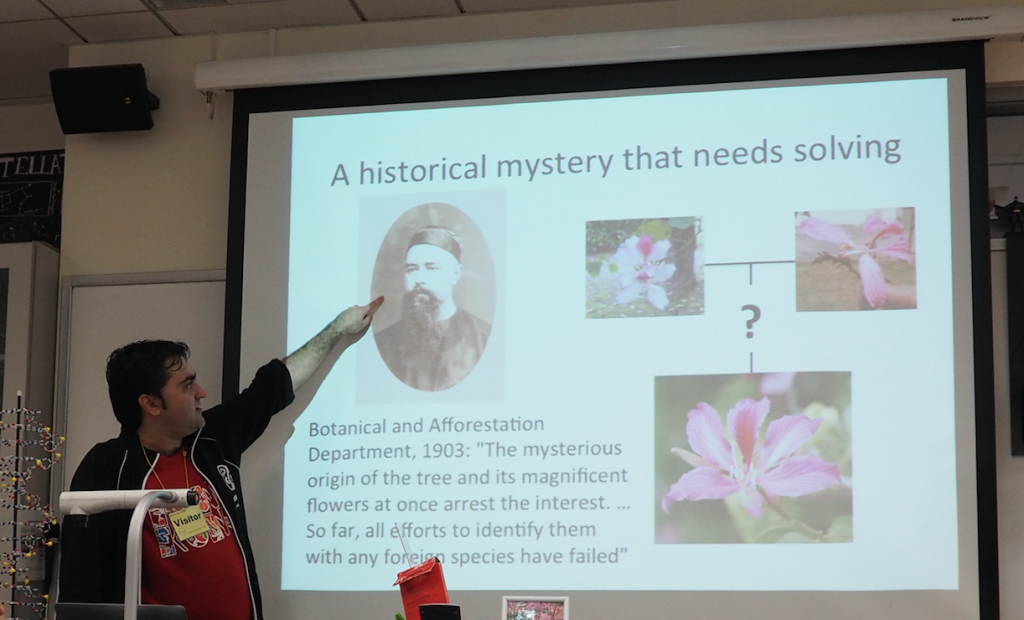DNA Day 2025: Mission Accomplished for Bauhinia Genome

Regular readers may have followed our community genome project Bauhinia Genome, and today marks the end of this journey with the publication in GigaScience of completely gapless telomere-to-telomere (T2T) genome assembly which helps advance our understanding of the genomic structure underlying the captivating traits of Hong Kong’s floral emblem.
The 25th April is International DNA Day, and this year it marks the completion of a decade-long project to sequence the DNA of Hong Kong’s floral emblem, the Hong Kong Orchid Tree Bauhinia x blakeana Dunn. The study, published today in GigaScience and led by scientists from Chinese University of Hong Kong (CUHK), presents a complete, gapless sequence of the Bauhinia genome, spanning from one end of a chromosome to the other. Featured on the Hong Kong flag and currency, this beautiful ornamental Bauhinia species – admired for its striking purplish orchid-like flowers – can be traced back to a chance discovery by French horticulturalist Jean-Marie Delavay on Hong Kong Island in the 1880s. It was later determined to be completely sterile and could only be grown by being propagated from cuttings, thus making the taxonomic status and precise origin of this striking species a scientific mystery.

Teaching genomics and the historical mystery of Bauhinia’s origins in Hong Kong schools.
Morphological and single-gene and marker studies suggested the species may be a hybrid between Bauhinia purpurea and Bauhinia variegata, but until now there remains a lack of definitive confirmation, especially at the genomic level. Being based in Hong Kong, and inspired by the first community funded genome project of the Puerto Rican parrot, the historical and cultural interest of Hong Kong Bauhinia led to our involvement in a community-crowdfunded genome project to try to answer some of the questions on the species’ origin. Reaching out directly to the Hong public and launching a crowdfunding campaign in 2015 raised enough money to start the Bauhinia Genome project and sequence the transcriptomes of the three key species. The team started progressing to full genomes in 2019 by combining state of the art second-generation and third-generation sequencing sequencing technologies. This multi-platform approach enabled the first chromosome scale draft assemblies of the hybrid and its putative parent species.
With the advent of the first human telomere-to-telomere (T2T) genome in 2023, computational biologists from the National University of Singapore refined the assembly using novel algorithms, achieving a T2T, haplotype-resolved genome. The final genome assembly revealing 28 complete chromosomes—14 inherited from each parent—forged through a singular hybridization event, a genetic chimera powering its vibrant blooms and ecological adaptability. This new T2T-level assembly finally completes the sequencing effort, allows precise tracking and analysis of genetic variations across parental lines and their hybrid offspring, and facilitates a comprehensive understanding of the underlying genetic mechanisms of its unusual flowering and reproductive traits. And also making this work fit in our T2T-Series of papers that we are currently seeking submissions (see more on our T2T series in another DNA Day posting).
The project definitively resolves the question of the Hong Kong Bauhinia’s parentage, with B. variegata identified as the paternal parent and B. purpurea as the maternal parent. Creating a hybrid despite the two species being separated over 13.4 million years. Transcriptome profiling of flower tissues highlighted a closer resemblance of B. blakeana to the maternal parent, and revealed distinct expression patterns among the three species, particularly in biosynthetic and metabolic processes. The new transcriptome data also throws light on the process of heterosis or hybrid vigor, the phenomenon in which hybrid offspring display enhanced or superior traits compared to their parents.
GigaScience‘s Scott Edmunds, co-founder of the community driven Bauhinia Genome Project says of this effort: “When we launched this grass-roots community project to educate the public on the potential of the rapid development of genomics, little did we know we would end up with a complete genome with no gaps covering all the 290.7 million base-pairs. Complete T2T genomics was not possible when we proposed the project due the accuracy and cost of the technology at the time. Starting as a citizen-science project appealing to the public by doing outreach and talks in Hong Kong schools, radio and TV; it is immensely satisfying to be able to say “mission accomplished” on the Bauhinia Genome.”

Through the production of this haplotype-resolved and gapless T2T genome, this work has advanced our understanding of the genomic structure and genetic mechanisms underlying the captivating flower colours traits and extended flowering period of in this popular and enigmatic ornamental tree, serving as a case study for investigating traits in other hybrid species. The stress resistance-related genes, floral trait regulation genes, and medicinal component-related genes identified in this research offer a plethora of novel molecular targets for future applications, including improving plant stress resistance, optimizing ornamental traits, and advancing the biosynthesis of pharmacologically active compounds.
Stephen Tsui, a Hong Kong citizen and Professor at The Chinese University of Hong Kong says of his journey to finish the T2T genome of Bauhinia “Hybrid genomes present significant assembly challenges due to their high heterozygosity and structural complexity. To address this, we integrated trio-binning with custom algorithms, achieving complete T2T assemblies for both parental haplotypes of Bauhinia × blakeana using only ~60x long-read data—a notable improvement over conventional workflows. By decoding these haplotypes, we not only solved the century-old mystery of its origin but also revealed how parental allele interactions shape the hybrid’s iconic floral characteristics. Our work also serves as a model for exploring the characteristics of hybrid species using T2T haplotype-resolved genomes, providing a novel approach to understanding genetic interactions and evolutionary mechanisms in complex genomes with high heterozygosity. Lastly, my team is very proud to have been able to complete the genome of Bauhinia, which is the emblem of Hong Kong”
As an open science project all the resources generated in this study have been made freely available for future genetic studies, breeding programs, and conservation initiatives in Bauhinia species. Additionally helping to showcase and teach open science practices. For more see the BauhiniaGenome.hk website, protocols, OER commons teaching materials, GBIF observations, and TEDx talk for more on how this project has been used for education and genomic literacy in Hong Kong.
References:
Mu et al. The haplotype-resolved T2T genome for Bauhinia × blakeana sheds light on the genetic basis of flower heterosis. GigaScience. 2025. https://doi.org/10.1093/gigascience/giaf044
O’Brien SJ. Genome empowerment for the Puerto Rican parrot – Amazona vittata. Gigascience. 2012 Sep 28;1(1):13. doi: 10.1186/2047-217X-1-13.